M1U1_Do_you_use_chopsticks_in_the UK
- 格式:ppt
- 大小:1.31 MB
- 文档页数:31
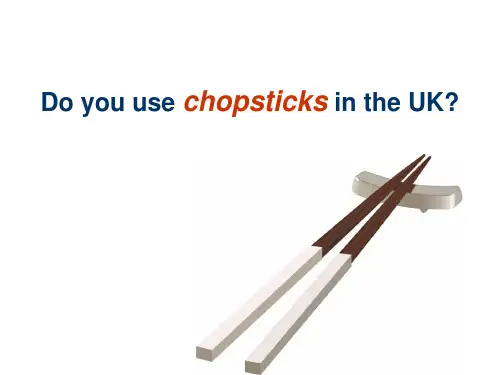
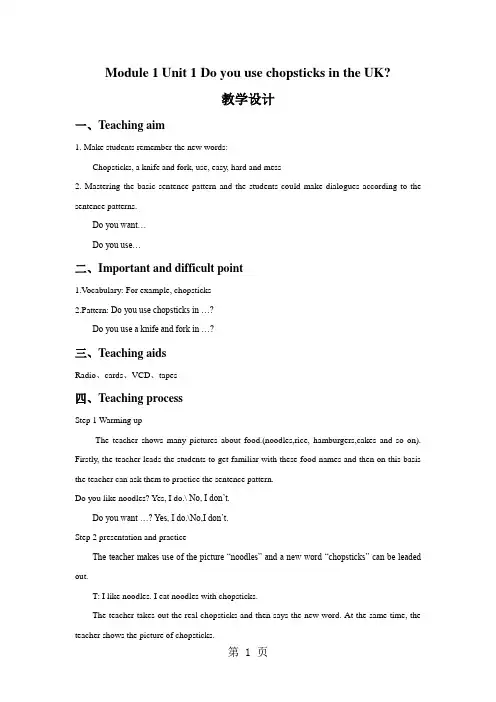
Module 1 Unit 1 Do you use chopsticks in the UK?教学设计一、Teaching aim1. Make students remember the new words:Chopsticks, a knife and fork, use, easy, hard and mess2. Mastering the basic sentence pattern and the students could make dialogues according to the sentence patterns.Do you want…Do you use…二、Important and difficult point1.V ocabulary: For example, chopsticks2.Pattern: Do you use chopsticks in …?Do you use a knife and fork in …?三、Teaching aidsRadio、cards、VCD、tapes四、Teaching processStep 1 Warming upThe teacher shows many pictures about food.(noodles,rice, hamburgers,cakes and so on). Firstly, the teacher leads the students to get familiar with these food names and then on this basis the teacher can ask them to practice the sentence pattern.Do you like noodles? Yes, I do.\ No, I don’t.Do you want …? Yes, I do.\No,I don’t.Step 2 presentation and practiceThe teacher makes use of the picture “noodles” and a new word “chopsticks” can be leaded out.T: I like noodles. I eat noodles with chopsticks.The teacher takes out the real chopsticks and then says the new word. At the same time, the teacher shows the picture of chopsticks.An activity can be made here. The title of the activity is saying words as quickly. The pronunciation of new word is a difficult point. So the teacher should ask students to practice more. Step 3The new word “use” can be leaded out in the process of communication.T: Can you use chopsticks?The word card of use should be shown.We use chopsticks in China. And the teacher writes the sentence on the blackboard.We use chopsticks.Do you use chopsticks? Yes, we do. No, we don’t.Ask and answer in pairs.The teacher inquires the students if the English people useChopsticks and a knife and fork will be leaded out.T: We use chopsticks in China. Do the English people use chopsticks?S: No, they don’t.English people use a knife and fork.Do you use chopsticks / a knife and fork? Yes, I do. No, I don’t.Step 4(1)Presentation of the text.Amy and Daming are in the park. They want to eat noodles. Watch the CD-ROM, then answer the questions: “Does Amy use chopsticks in England?”The students look at the CO-ROM and then answer questions.Now Amy is using chopsticks. Watch again, then answer the next question: Are the chopsticks “easy” or “hard” for her?easy – hardChopsticks are hard for Amy.A knife and fork are easy for her.Some other oposite words are shown here.big-smalllong-shortfat-thinhot-coldwhite-blackeasy-hardListen again, then answer:Are the chopsticks “easy” or “hard” for English people?T: If I say “big”. You should say “small”. Please say the words as quickly as you can.Chopsticks are hard for English people. So Amy make the mess.Then the students read the passage again.Find the sentences, “ Do you …?”. Then circ le them.五、Homework1. Read the dialogue and the sentence.2. Preview Module 1 Unit 2.。
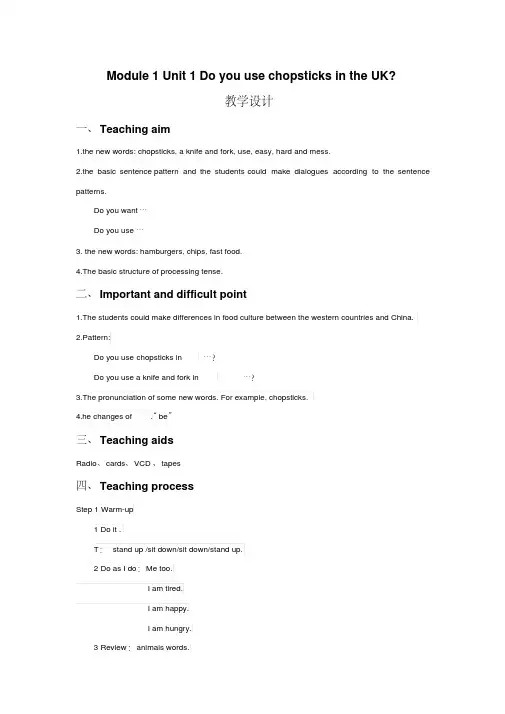
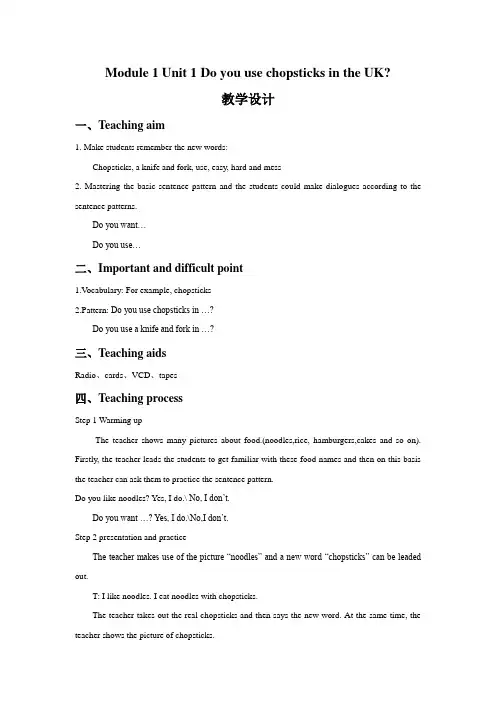
Module 1 Unit 1 Do you use chopsticks in the UK?教学设计一、Teaching aim1. Make students remember the new words:Chopsticks, a knife and fork, use, easy, hard and mess2. Mastering the basic sentence pattern and the students could make dialogues according to the sentence patterns.Do you want…Do you use…二、Important and difficult point1.V ocabulary: For example, chopsticks2.Pattern: Do you use chopsticks in …?Do you use a knife and fork in …?三、Teaching aidsRadio、cards、VCD、tapes四、Teaching processStep 1 Warming upThe teacher shows many pictures about food.(noodles,rice, hamburgers,cakes and so on). Firstly, the teacher leads the students to get familiar with these food names and then on this basis the teacher can ask them to practice the sentence pattern.Do you like noodles? Yes, I do.\ No, I don’t.Do you want …? Yes, I do.\No,I don’t.Step 2 presentation and practiceThe teacher makes use of the picture “noodles” and a new word “chopsticks” can be leaded out.T: I like noodles. I eat noodles with chopsticks.The teacher takes out the real chopsticks and then says the new word. At the same time, the teacher shows the picture of chopsticks.An activity can be made here. The title of the activity is saying words as quickly. The pronunciation of new word is a difficult point. So the teacher should ask students to practice more. Step 3The new word “use” can be leaded out in the process of communication.T: Can you use chopsticks?The word card of use should be shown.We use chopsticks in China. And the teacher writes the sentence on the blackboard.We use chopsticks.Do you use chopsticks? Yes, we do. No, we don’t.Ask and answer in pairs.The teacher inquires the students if the English people useChopsticks and a knife and fork will be leaded out.T: We use chopsticks in China. Do the English people use chopsticks?S: No, they don’t.English people use a knife and fork.Do you use chopsticks / a knife and fork? Yes, I do. No, I don’t.Step 4(1)Presentation of the text.Amy and Daming are in the park. They want to eat noodles. Watch the CD-ROM, then answer the questions: “Does Amy use chopsticks in England?”The students look at the CO-ROM and then answer questions.Now Amy is using chopsticks. Watch again, then answer the next question: Are the chopsticks “easy” or “hard” for her?easy – hardChopsticks are hard for Amy.A knife and fork are easy for her.Some other oposite words are shown here.big-smalllong-shortfat-thinhot-coldwhite-blackeasy-hardListen again, then answer:Are the chopsticks “easy” or “hard” for English people?T: If I say “big”. You should say “small”. Please say the words as quickly as you can.Chopsticks are hard for English people. So Amy make the mess.Then the students read the passage again.Find the sentences, “ Do you …?”. Then circle them.五、Homework1. Read the dialogue and the sentence.2. Preview Module 1 Unit 2.。
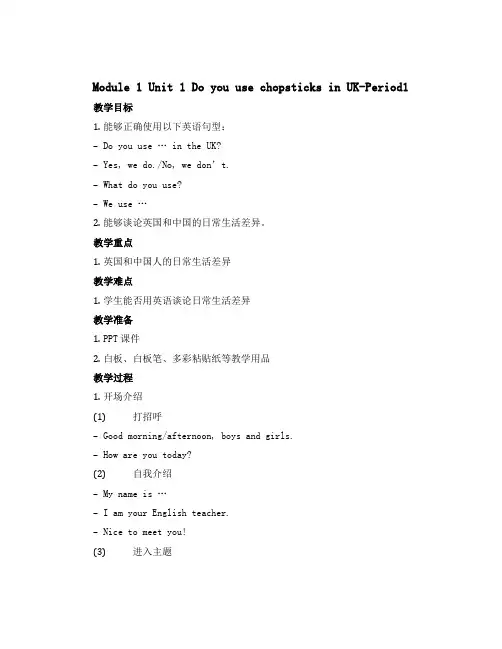
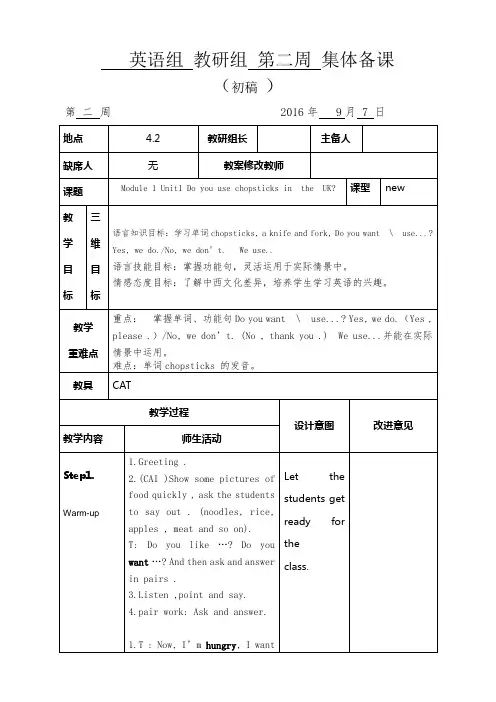
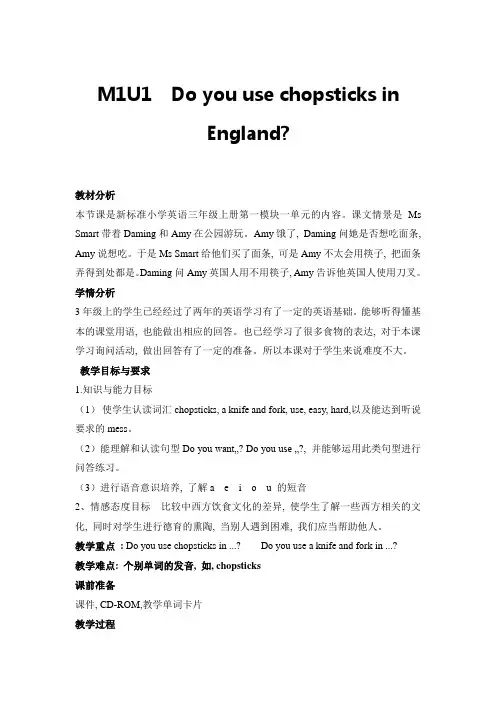
M1U1 Do you use chopsticks inEngland?教材分析本节课是新标准小学英语三年级上册第一模块一单元的内容。
课文情景是Ms Smart带着Daming和Amy在公园游玩。
Amy饿了, Daming问她是否想吃面条, Amy说想吃。
于是Ms Smart给他们买了面条, 可是Amy不太会用筷子, 把面条弄得到处都是。
Daming问Amy英国人用不用筷子, Amy告诉他英国人使用刀叉。
学情分析3年级上的学生已经经过了两年的英语学习有了一定的英语基础。
能够听得懂基本的课堂用语, 也能做出相应的回答。
也已经学习了很多食物的表达, 对于本课学习询问活动, 做出回答有了一定的准备。
所以本课对于学生来说难度不大。
教学目标与要求1.知识与能力目标(1)使学生认读词汇chopsticks, a knife and fork, use, easy, hard,以及能达到听说要求的mess。
(2)能理解和认读句型Do you want…? Do you use …?, 并能够运用此类句型进行问答练习。
(3)进行语音意识培养, 了解a e i o u 的短音2、情感态度目标比较中西方饮食文化的差异, 使学生了解一些西方相关的文化, 同时对学生进行德育的熏陶, 当别人遇到困难, 我们应当帮助他人。
教学重点: Do you use chopsticks in ...? Do you use a knife and fork in ...?教学难点: 个别单词的发音, 如, chopsticks课前准备课件, CD-ROM,教学单词卡片教学过程Step 1.Warm up1.出示大量食物的图片( noodles, rice, hamburgers, cakes, etc.)先引导学生复习这些食型:Do you like noodles? Yes, I do. No, I don’t.Do you want ...? Yes, I do. No, I don’t.Step 2 Presentation and practice1.(1) 教师借用noodles这张图片引出chopsticksT: I like noodles.I eat noodles with chopsticks.拿出实物“筷子”, 边做动作边说chopsticks 引出单词并出示卡片。
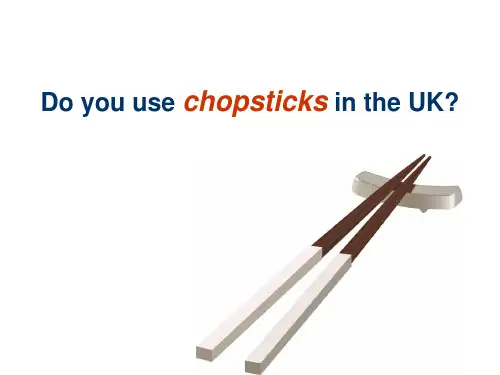
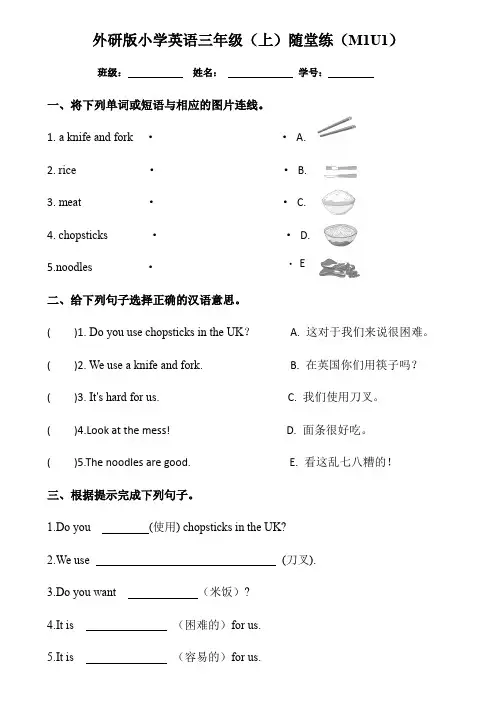
外研版小学英语三年级(上)随堂练(M1U1)班级:姓名:学号:一、将下列单词或短语与相应的图片连线。
1. a knife and fork··A.2. rice··B.3. meat··C.4. chopsticks ··D.·E5.noodles·二、给下列句子选择正确的汉语意思。
()1. Do you use chopsticks in the UK? A. 这对于我们来说很困难。
()2. We use a knife and fork. B. 在英国你们用筷子吗?()3. It's hard for us. C. 我们使用刀叉。
()4.Look at the mess! D. 面条很好吃。
()5.The noodles are good. E. 看这乱七八糟的!三、根据提示完成下列句子。
1.Do you (使用) chopsticks in the UK?2.We use (刀叉).3.Do you want (米饭)?4.It is (困难的)for us.5.It is (容易的)for us.外研版小学英语三年级(上)随堂练(M1U2)班级:姓名:学号:一、选出与画线单词同类的一项。
()1. I want some rice.A. useB. chipsC. knife()2. Do you want noodles?A. easyB. hungryC. eat()3. I'm eating grass.A. meatB. messC. hungry()4. It's hard for us.A. youB. easyC. we()5. I'm using my hands.A. eatingB. foodC. fork二、选择最佳答案。
()1. I'm ________ a knife and fork.A. useB. usingC. uses()2. — What ________ you eating?— I'm eating noodlesA. areB. isC. do()3. — Do you use a knife and fork?— ________,I use chopsticks.A. HiB. YesC. No()4. It's ________ fast food.A.the UKB. ChinaC. Chinese三、阅读短文,判断下列句子是否正确,正确的写“T”,不正确的写“F”。
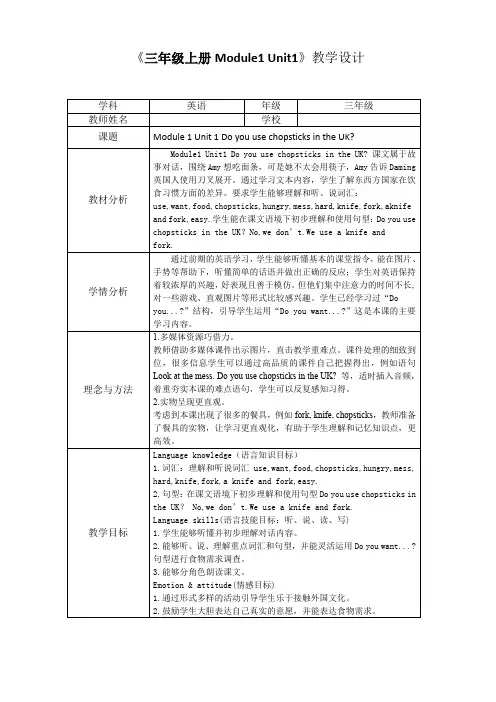
《三年级上册Module1 Unit1》教学设计
this step, they discuss in their groups,share their own information and consolidate the key points.生在轻松的氛围中巩固了本课的重点单词和句型。
Summarize What have you learnt today?回顾本课所学。
Homework 1.Read and imitate the text.
2.Finish your dinner list and
share with your parents.
布置本课作业。
课堂评价方式教师评价、学生互评板书设计思路
教学反思
回顾本次授课,达到了预期的教学目标,整体来说学生参与度较高,生动的多媒体课件配合实物,学生兴趣十足。
特别是对于重点语句Do you use chopsticks...?No, we don’t. We use a knife and fork.的学习,老师搭建了语言支架,在pair work中,同位两人进行了充分的练习,夯实了难点。
巩固操练环节由易到难,由词到句,从重点单词的复现到课文的复述,最后直接呈现了语言任务:Dinner list,让学生制作自己的晚餐清单,任务真实有效,有助于提高学生的综合语用能力。
反思本节课,教师的评价语言有些单一,主要集中在Good! Well done! Wonderful! Right! 等语句,教师评语可以针对学生的回答更丰富一些,如I like your voice. I agree with you! 等。
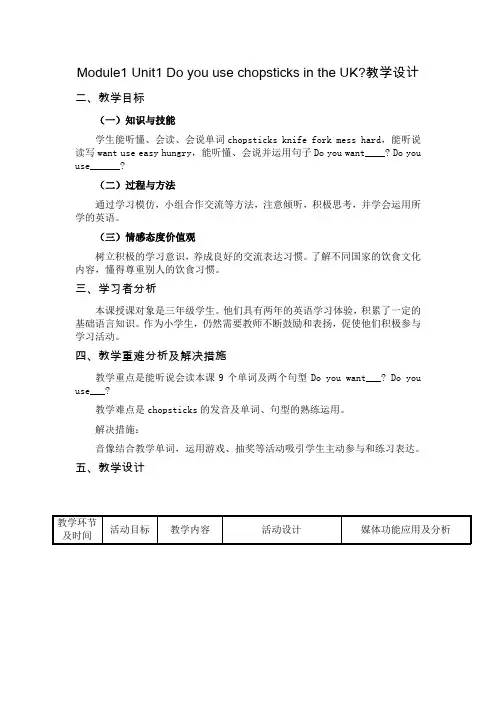
Module1 Unit1 Do you use chopsticks in the UK?教学设计二、教学目标
(一)知识与技能
学生能听懂、会读、会说单词chopsticks knife fork mess hard,能听说读写want use easy hungry,能听懂、会说并运用句子Do you want____? Do you use______?
(二)过程与方法
通过学习模仿,小组合作交流等方法,注意倾听,积极思考,并学会运用所学的英语。
(三)情感态度价值观
树立积极的学习意识,养成良好的交流表达习惯。
了解不同国家的饮食文化内容,懂得尊重别人的饮食习惯。
三、学习者分析
本课授课对象是三年级学生。
他们具有两年的英语学习体验,积累了一定的基础语言知识。
作为小学生,仍然需要教师不断鼓励和表扬,促使他们积极参与学习活动。
四、教学重难分析及解决措施
教学重点是能听说会读本课9个单词及两个句型Do you want___? Do you use___?
教学难点是chopsticks的发音及单词、句型的熟练运用。
解决措施:
音像结合教学单词,运用游戏、抽奖等活动吸引学生主动参与和练习表达。
五、教学设计。
Module 1 Unit 1 Do you use chopsticks in the UK?教学设计一、 Teaching aim1. Make stude nts remember the new words:Chopsticks, a knife and fork, use, easy, hard and mess2. Masteri ng the basic sentence patter n and the stude nts could make dialogues accord ing to thesentence patter ns.Do you want …Do you use …二、Important and difficult point〔.Vocabulary: For example, chopsticks2.Patter n: Do you use chopsticks in …?Do you use a knife and fork in …?三、Teaching aidsRadio、cards、VCD、tapes四、Teaching processStep 1 Warmi ng upThe teacher shows many pictures about food.(noodles,rice, hamburgers,cakes and so on).Firstly, the teacher leads the stude nts to get familiar with these food n ames and the n on this basisthe teacher can ask them to practice the sentence patter n.Do you like noodles? Yes, I do.\ No, I don ' t.Do you want …? Yes, I do.No,I don ' t.Step 2 prese ntati on and practiceThe teacher makes use of the picture "noodles ” and a new word “chopsticks ” can be leaded out.T: I like no odles. I eat no odles with chopsticks.The teacher takes out the real chopsticks and then says the new word. At the same time, theteacher shows the picture of chopsticks.An activity can be made here. The title of the activity is saying words as quickly. The pronun ciatio n of new word is a difficult point. So the teacher should ask stude nts to practice more. Step 3The new word “ use” can be leaded out in the process of com muni catio n.T: Can you use chopsticks?The word card of use should be show n.We use chopsticks in China. And the teacher writes the sentence on the blackboard.We use chopsticks.Do you use chopsticks? Yes, we do. No, we don ' t.Ask and an swer in pairs.The teacher inqu ires the stude nts if the En glish people useChopsticks and a knife and fork will be leaded out.T: We use chopsticks in China. Do the En glish people use chopsticks? |S: No, they don ' t.En glish people use a knife and fork.Do you use chopsticks / a knife and fork? Yes, I do. No, I don ' t.Step 4⑴Prese ntati on of the text.Amy and Daming are in the park. They want to eat noodles. Watch the CD-ROM, then answer the questions:“ Does Amy use chopsticks in England? ”The stude nts look at the CO-ROM and the n an swer questi ons.Now Amy is using chopsticks. Watch again, then answer the next question: Are the chopsticks “ easy ” or “ hard ” for her?easy -hardChopsticks are hard for Amy.A knife and fork are easy for her.Some other oposite words are show n here.big-smallIon g-shortfat-th inhot-coldwhite-blackeasy-hardListe n aga in, the n an swer:Are the chopsticks “easy” or “hard ” for English people?T: If I say “ big ” . You should say “ small” . Please say the words as quickly as you can.Chopsticks are hard for En glish people. So Amy make the mess.Then the stude nts read the passage aga in.Find the sentences, “ Do you …?” . Then circle them.五、Homework1. Read the dialogue and the sentence.2. Preview Module 1 Unit 2.。